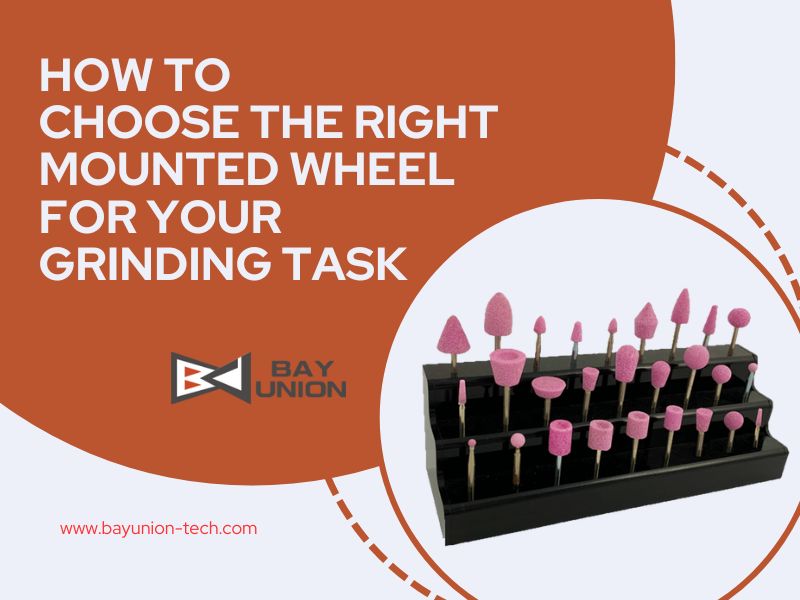
How to Choose the Right Mounted Wheel for Your Grinding Task
Introduction
When it comes to precision grinding and deburring, the mounted wheel is one of the most versatile and essential tools in industrial machining. Whether you're polishing mold cavities, removing burrs from intricate parts, or refining detailed contours, choosing the right mounted wheel can significantly impact your efficiency and results.
As a leading manufacturer of abrasive solutions, Bay Union is dedicated to helping professionals select the ideal mounted wheel for their specific needs. This article outlines the key factors to consider—such as abrasive type, grit size, bond material, and shape—to ensure optimal grinding performance across a range of applications.
1. Choose the Right Abrasive Material
The abrasive material determines how effectively the mounted wheel can cut or grind specific workpieces:
- • Aluminum Oxide (A/O): Great for general-purpose grinding on steel and ferrous metals.
- • Silicon Carbide (SiC): Best for softer materials such as aluminum, brass, rubber, or stone.
- • CBN (Cubic Boron Nitride): Designed for hardened steels and heat-treated alloys.
- • Diamond: Ideal for non-metallic materials like glass, ceramics, and carbide.
2. Select the Proper Grit Size
Grit size affects both cutting performance and surface finish:
- • Coarse Grit (46–60): Removes material quickly, suitable for rough grinding.
- • Medium Grit (80–120): Ideal for general-purpose applications.
- • Fine Grit (150+): Used for fine finishing or polishing tasks requiring smooth surfaces.
3. Common Bond Types
The bond holds the abrasive grains in place. Two of the most common bond types for mounted wheels are:
- • Vitrified Bond: Known for strength, rigidity, and heat resistance—suitable for high-precision grinding.
- • Resin Bond: More elastic and forgiving—ideal for smooth finishes and softer materials.
Choosing the right bond depends on the nature of your workpiece and grinding requirements.
4. Common Shapes and Uses
Mounted wheels come in various shapes to suit different grinding needs. Some of the most commonly used include:
- • Straight (cylindrical): The most standard type, used for general grinding and internal surfaces.
- • Conical: Great for reaching narrow spaces or angled surfaces.
- • Ball/Bullet: Suitable for detailed deburring or curved internal shapes.
- • Tapered or Oval: Used for heavier material removal or complex contours.
Selecting the appropriate shape ensures better access to the workpiece and improved grinding control.
5. Shank Size Compatibility
Make sure the mounted wheel's shank size matches your tool or machine collet. Common shank sizes include 3mm and 6mm. At Bay Union, we offer custom shank dimensions to suit a variety of machine types and applications.
6. Consider the Workpiece Material and Grinding Speed
Different materials and grinding speeds may require different types of mounted wheels. For harder metals or high-speed grinding, a vitrified bond and harder abrasive like CBN may be appropriate. For softer materials or slower speeds, a resin bond may be more effective.
Always follow recommended RPM ratings for safety and best results.
7. Partner with a Trusted Manufacturer
Choosing a high-quality mounted wheel goes beyond just specifications—it's also about reliability and consistent performance. That's why Bay Union offers a complete line of mounted wheels built for durability, precision, and versatility.
Bay Union's Mounted Wheel Solutions:
- • Type A: Designed for offhand grinding in foundries, steel plants, and general metalwork.
- • Type B: Perfect for light deburring in tool and die applications.
- • Type W: Suited for medium to heavy stock removal in precision grinding tasks.
- • Custom options: Various shank diameters, lengths, and specifications available on request.
Crafted from premium abrasives and engineered with care, Bay Union's mounted wheels deliver consistent results, longer tool life, and optimized grinding performance.
Conclusion
Selecting the right mounted wheel is essential to achieving optimal grinding performance and finish quality. By understanding the basics—abrasive material, grit size, bond type, shape, and compatibility—you can ensure you're using the most effective tool for your specific task.
Explore Bay Union's full line of mounted wheels and discover how we can help improve your grinding process with products that combine performance, reliability, and customizability.
Let us help you find the perfect solution for your grinding needs.
